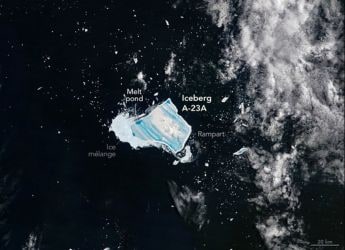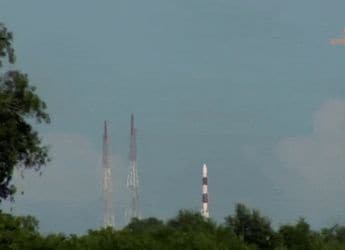- Home
- Science
- Science News
- Nasa's New Horizons Probe Begins Beaming Pluto Data to Earth
Nasa's New Horizons Probe Begins Beaming Pluto Data to Earth

The process moved into high gear on September 5 with the entire downlink taking about one year to complete.
"These images, spectra and other data types that are going to help us understand the origin and the evolution of the Pluto system for the first time," said New Horizons principal investigator Alan Stern fr om the Southwest Research Institute (SwRI) in Boulder, Colorado.
"It is the best datasets, the highest-resolution images and spectra, the most important atmospheric datasets, and more. It's a treasure trove," he added in a Nasa statement.
Even moving at light speed, the radio signals from New Horizons containing data need more than four and a half hours to cover the three billion miles to reach Earth.
Since late July, New Horizons has only been sending back lower data-rate information collected by the energetic particle, solar wind and space dust instruments.
The pace picked up considerably on September 5 as it resumed sending flyby images and other data.
During the data downlink phase, the spacecraft transmits science and operations data to Nasa's Deep Space Network (DSN) of antenna stations, which also provide services to other missions, like Voyager.
"The New Horizons mission has required patience for many years, but from the small amount of data we saw around the Pluto flyby, we know the results to come will be well worth the wait," added Hal Weaver, New Horizons project scientist from the Johns Hopkins University.
The team also plans to continue posting new, unprocessed pictures from the Long Range Reconnaissance Imager (LORRI) on the New Horizons project website each Friday.
Catch the latest from the Consumer Electronics Show on Gadgets 360, at our CES 2026 hub.
Related Stories
- Samsung Galaxy Unpacked 2025
- ChatGPT
- Redmi Note 14 Pro+
- iPhone 16
- Apple Vision Pro
- Oneplus 12
- OnePlus Nord CE 3 Lite 5G
- iPhone 13
- Xiaomi 14 Pro
- Oppo Find N3
- Tecno Spark Go (2023)
- Realme V30
- Best Phones Under 25000
- Samsung Galaxy S24 Series
- Cryptocurrency
- iQoo 12
- Samsung Galaxy S24 Ultra
- Giottus
- Samsung Galaxy Z Flip 5
- Apple 'Scary Fast'
- Housefull 5
- GoPro Hero 12 Black Review
- Invincible Season 2
- JioGlass
- HD Ready TV
- Laptop Under 50000
- Smartwatch Under 10000
- Latest Mobile Phones
- Compare Phones
- OnePlus Turbo 6V
- OnePlus Turbo 6
- Itel Zeno 20 Max
- OPPO Reno 15 Pro Mini 5G
- Poco M8 Pro 5G
- Motorola Signature
- Vivo Y50e 5G
- Vivo Y50s 5G
- Lenovo Yoga Slim 7x (2025)
- Lenovo Yoga Slim 7a
- Realme Pad 3
- OPPO Pad Air 5
- Xiaomi Watch 5
- Huawei Watch 10th Anniversary Edition
- Acerpure Nitro Z Series 100-inch QLED TV
- Samsung 43 Inch LED Ultra HD (4K) Smart TV (UA43UE81AFULXL)
- Asus ROG Ally
- Nintendo Switch Lite
- Haier 1.6 Ton 5 Star Inverter Split AC (HSU19G-MZAID5BN-INV)
- Haier 1.6 Ton 5 Star Inverter Split AC (HSU19G-MZAIM5BN-INV)

















